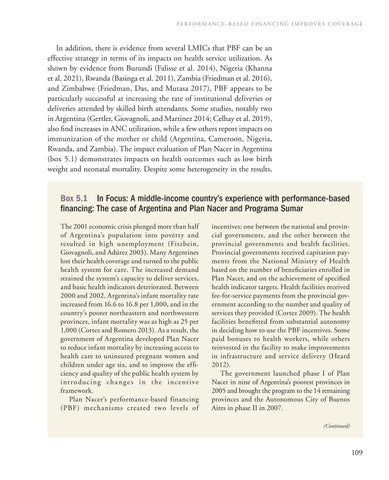P erformance - B ased F inancing I mproves C overage
In addition, there is evidence from several LMICs that PBF can be an effective strategy in terms of its impacts on health service utilization. As shown by evidence from Burundi (Falisse et al. 2014), Nigeria (Khanna et al. 2021), Rwanda (Basinga et al. 2011), Zambia (Friedman et al. 2016), and Zimbabwe (Friedman, Das, and Mutasa 2017), PBF appears to be particularly successful at increasing the rate of institutional deliveries or deliveries attended by skilled birth attendants. Some studies, notably two in Argentina (Gertler, Giovagnoli, and Martinez 2014; Celhay et al. 2019), also find increases in ANC utilization, while a few others report impacts on immunization of the mother or child (Argentina, Cameroon, Nigeria, Rwanda, and Zambia). The impact evaluation of Plan Nacer in Argentina (box 5.1) demonstrates impacts on health outcomes such as low birth weight and neonatal mortality. Despite some heterogeneity in the results,
Box 5.1 In Focus: A middle-income country’s experience with performance-based financing: The case of Argentina and Plan Nacer and Programa Sumar The 2001 economic crisis plunged more than half of Argentina’s population into poverty and resulted in high unemployment (Fiszbein, Giovagnoli, and Adúrez 2003). Many Argentines lost their health coverage and turned to the public health system for care. The increased demand strained the s ystem’s capacity to deliver services, and basic health indicators deteriorated. Between 2000 and 2002, Argentina’s infant mortality rate increased from 16.6 to 16.8 per 1,000, and in the country’s poorer northeastern and northwestern provinces, infant mortality was as high as 25 per 1,000 (Cortez and Romero 2013). As a result, the government of Argentina developed Plan Nacer to reduce infant mortality by increasing access to health care to uninsured pregnant women and children under age six, and to improve the efficiency and quality of the public health system by i nt ro duc i n g c h a n g e s i n t he i nc e nt i ve framework. Plan Nacer’s performance-based financing (PBF) mechanisms created two levels of
incentives: one between the national and provincial governments, and the other between the provincial governments and health facilities. Provincial governments received capitation payments from the National Ministry of Health based on the number of beneficiaries enrolled in Plan Nacer, and on the achievement of specified health indicator targets. Health facilities received fee-for-service payments from the provincial government a ccording to the number and quality of services they provided (Cortez 2009). The health facilities benefitted from substantial autonomy in deciding how to use the PBF incentives. Some paid bonuses to health workers, while others reinvested in the facility to make improvements in infrastructure and service delivery (Heard 2012). The government launched phase I of Plan Nacer in nine of Argentina’s poorest provinces in 2005 and brought the program to the 14 remaining provinces and the Autonomous City of Buenos Aires in phase II in 2007. (Continued)
109

